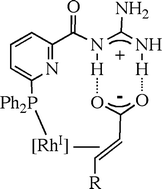Multifunctional ligands in transition metal catalysis
Abstract
Sophisticated ligands are now being designed that do far more than just fulfil their traditional spectator roles by binding to the metal and providing a sterically-defined binding pocket for the substrate in homogeneous transition metal catalysis. This Focus review emphasizes selected cases in which ligands carry additional functional


 Please wait while we load your content...
Please wait while we load your content...